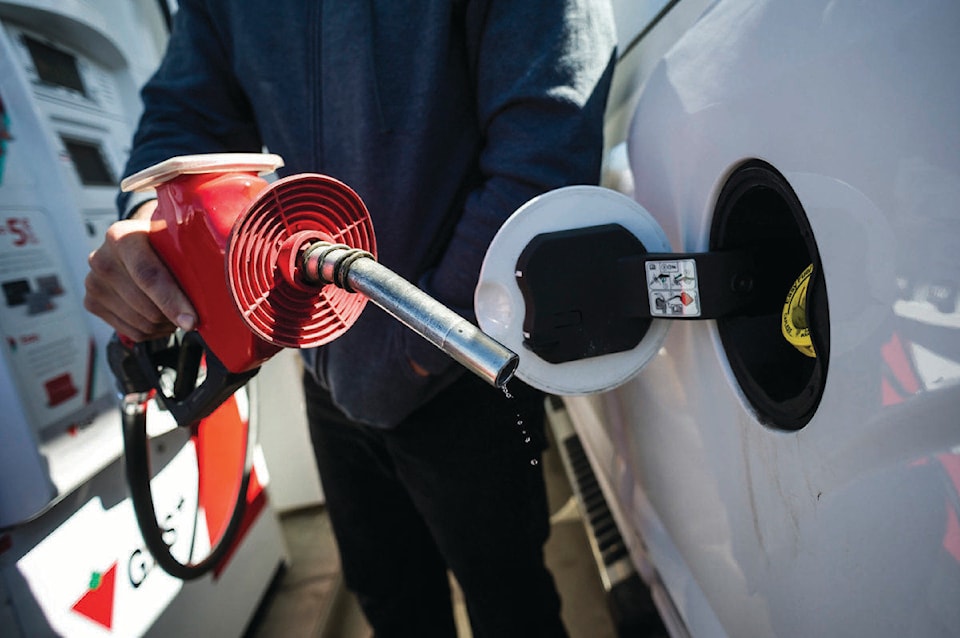When it comes to high gas prices in Kitimat, one man says he has had enough.
Daniel Carter has been fighting for lower gas prices and more transparency in reporting inflated prices since last summer when he saw rising costs across the province, especially in smaller rural areas like Kitimat.
In that time he has written a number of letters to both the British Columbia Utilities Commission and the federal Competition Bureau to express his concerns about gas pricing in the province.
Most recently, Carter sent out a letter to a number of politicians and others related to natural resources in the province, including Skeena MLA Ellis Ross, Skeena-Bulkley Valley MP Taylor Bachrach, Kevin Pei at Natural Resources Canada and Suncor Energy.
READ MORE: Cheapest in B.C.: Penticton gas prices dip below $1
In his letter, Carter expresses disappointment in the disparity between the “rack price”, or the price at which gas is sold in bulk stations in places such as Terrace, Smithers and Prince George and the price consumers are paying at the pump.
“I live in Kitimat where the price rarely drops as fast as other places, it is now roughly 20 cents higher retail than Prince George with the shipped rack price,” he begins his letter. “I thought that there were tools in place to monitor and regulate these prices [but] so far I have seen hardly any reduction in price for over a month now, while the other gas stations in the province greatly reduce their prices.”
Carter said his question is simple. “Why can’t Kitimat, Terrace and Smithers enjoy the same prices [as] retailers in Moricetown and Hazelton with sub-dollar prices that are within the same region?
“If people can sell it at 78 to 83 cents a litre in the province and we are selling it retail at 100.1, there’s something wrong.”
Carter said he has tried to get in contact with the three companies which have stations in Kitimat: Esso, Shell and Husky. However he says he has only had real success with Husky Canada.
“The other stations are pretty tight-lipped about it,” he said, adding that even Husky gives him quite generic responses when he has gotten in touch with their ethics department to ask about pricing. “It’s basically saying that they’re within normal prices,” he said, adding that they have said they cannot reveal more information as it could divulge sensitive pricing information, something Carter doesn’t buy. “I don’t believe that at all, because generally within a town there’s no big spread on prices, so that just didn’t make sense to me.”
Carter also publicly posted a response he received from Bachrach, who noted that high gas prices are a common concern he hears from residents.
“The province of BC recently passed legislation requiring gas companies to disclose to the BC Utilities Commission the market information on which they base their prices,” Bachrach said in his response. “However, from what I can discern, there are still no restrictions on how much they charge at the pump, leaving individual companies and stations to determine what they feel the market will bear.”
In the end of his letter Bachrach suggests the Province could possibly take note from Nova Scotia, which currently regulates the price of gas at the pump. “It may be time for BC to consider something similar so certain northern communities aren’t penalized with artificially-high prices.” However Bachrach also noted the issue was an area of provincial jurisdiction and that it would ultimately be up to the BC government to make the idea a reality.
In terms of what he would like to see from retailers, both the parent gas companies and various local retailers, Carter said it mainly boiled down to transparency. “[Parent companies aren’t] transparent enough and they don’t have a proper reporting [mechanism],” he said. “I think the general public should be able to report better.”
As for retailers, Carter said it’s a very similar issue of getting substantial answers.
“It’s usually the same answer … ‘we get a phone call, we adjust the price accordingly’, that’s the same answer I always get,” he said, adding that he is skeptical of this response and feels there could be more at play. “They’re hiding something, that’s my feel on this.”
As for the consumers, Carter acknowledged they’re stuck in between a rock and a hard place.
“We used to have some of the best prices across the province in Kitimat, but I’m going back 10 years now,” he said. “What I am saying to other people is we’re stuck buying fuel at these elevated prices, we do not have a choice, you know?” He said many people tell him they feel the prices exist because of the LNG industry’s heavy presence in the District and because people will ultimately pay the price at the pump. Regardless, Carter acknowledges people don’t have many other choices than to pay the price.
“We can’t drive to Terrace anymore because they’re at par, we can’t drive to Smithers anymore because they’re at par,” he said. “We can go to Prince George, which is half a day away, and buy it at a cheap rate but that doesn’t make any sense.
“We have no choice, and that’s a problem.”
trevor.hewitt@interior-news.com
Like us on Facebook and follow us on Twitter
